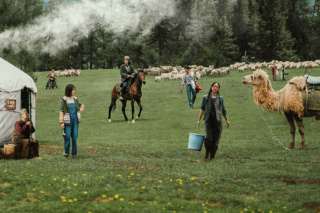TV series《To the Wonder》a story with the author Li Juan
The recently aired movie called "To the Wonder" has attracted widespread attention. Whether it is the appearance of the actors, their outstanding acting skills, or the dramatic plot, it has attracted a large number of viewers.At the same time, the story between the TV series - To the Wonder - and the author Li Juan has also become a hot topic of discussion among many viewers.Now let’s explore it together.
When Li Juan's collection of essays - To the Wonder - was adapted into a film and television work and presented on the big screen, it not only touched the audience's imagination of words, but also aroused strong visual and emotional resonance.The success of this work is not only due to the charm of the original work, but also due to the careful creation and presentation of director Teng Congcong and his team.
In the film, scenes that may seem subtle but are full of life wisdom, such as the humorous moment when a bull licks Andy Lau (billboard), not only made the audience laugh, but also showed Teng Congcong's appreciation for the delicate, touching and humorous nature of the original work.A perfect interpretation of the details of life.For this detail, the production team specially found Mr. Andy Lau and obtained the right to use his portrait, which reflects the team's ultimate pursuit of the quality of the work.
Teng Congcong's love for Li Juan's works stems from her shared feelings as a member of the post-80s generation.She mentioned that reading Li Juan's works made her feel the endlessness and vastness of being in a foreign land. This feeling is similar to the works of writers such as Jin Yong, Sanmao, and Zhang Ailing.It was this emotional resonance that made her decide to put "To the Wonder" on the big screen and share this touching feeling with more audiences.

Converting literary works into film and television works is not an easy task.During the creative process, Teng Congcong went deep into Altay to collect folk customs, ate and lived with local people, and experienced their lives.She discovered that there was a big gap between the Altay described in the original work and the real Altay.This gap is exactly what Teng Congcong wants to show through the film - the conflict and integration between nomadic culture and current civilization.
During the filming process, Teng Congcong and her team faced many challenges.As Han people, they are not good at herding, which became a big problem when filming on the grasslands.However, it is these challenges that make the film more real and vivid.Teng Congcong admitted that language is not the biggest barrier. The local people's way of doing things, simple folk customs and beautiful scenery have all become indispensable elements of the film.
It is worth mentioning that Teng Congcong's attention to detail and persistent spirit have enabled the film to reach a very high level in presentation.Even when faced with difficulties, she insisted on choosing the most suitable shooting location, such as the Renxia Ranch.Although the road there is winding and difficult, Teng Congcong believes that the air humidity, atmospheric transparency, vegetation appearance and other textural details there are irreplaceable by other grasslands.It is this extreme pursuit of details that allowed the film to cut out one-eighth of the entire drama in a short period of shooting, demonstrating the strength and ingenuity of an excellent director.
The above is an in-depth analysis of the story between the TV series - To the Wonder - and the author Li Juan. I believe this will give some readers a clearer understanding of related issues.If you think this article is helpful to you, we highly recommend you to continue to pay attention to the line lesson, because we will publish more detailed and rich content.Whether you are interested in this topic or want to learn about other areas, we will continue to bring you exciting content.
Website Disclaimer: The content of “TV series《To the Wonder》a story with the author Li Juan” on this site is provided by user "AetherArcher" and is for display purposes only. Copyright belongs to the original author. If your rights have been infringed, please contact us, and we will remove it as soon as possible.
- 1 Anime《Solo Leveling》Updated on days of the week
- 2 Netflix《Let's Talk About CHU》Character introduction
- 3 《to he first frest》Seeking Calendar
- 4 Thai Drama《Forbidden Friends》Episodes 1-12 (including ending)
- 5 《Nirvana against the light》Plot introduction
- 6 《liu zi mei》Seeking Drama Calendar
- 7 《to he first frest》Introduction to the full episode plot
- 8 Korean drama《Sweet Home 3》is confirmed to be released on July 19
- 9 《love of the divine tree》The drama calendar
- 10 《Can't hide a secret》Sang Yan's car
- 11 《aioweys tone》Seeking Drama Calendar
- 12 Korean drama《Grab your collar》Full episodes 1-16 (including ending)
- 13 《Let's Talk About CHU》Full episode plot introduction
- 14 《From a son-in-law to a favorite》Plot introduction
- 15 --The year-end bonus of five million-Plot introduction

